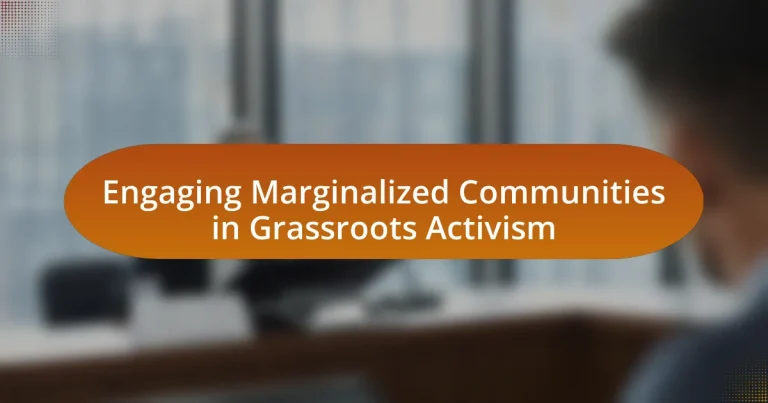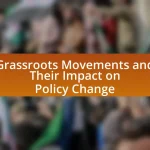Engaging marginalized communities in grassroots activism involves actively involving these groups in decision-making processes and advocating for their rights. This article explores how grassroots activism empowers these communities by providing platforms for their voices, fostering community engagement, and addressing systemic inequalities. Key principles such as inclusivity, sustainability, and local leadership are highlighted, along with strategies for effective engagement and the unique challenges faced by marginalized groups. The article also examines the differences between grassroots and traditional activism, the importance of community partnerships, and the outcomes of successful grassroots initiatives in driving social change.
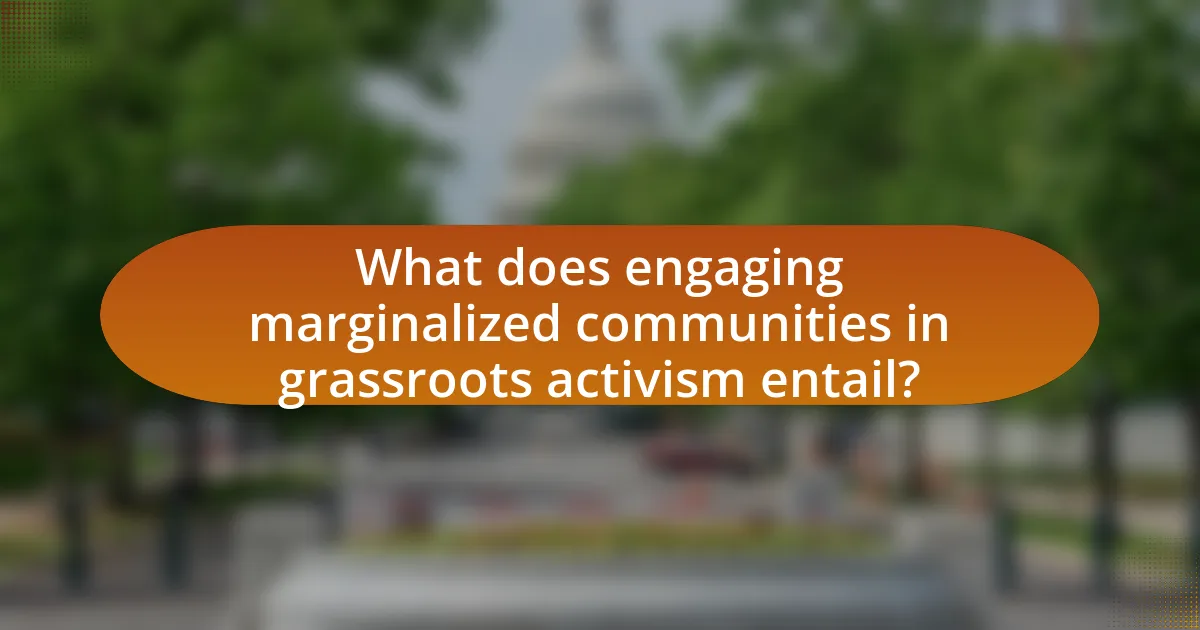
What does engaging marginalized communities in grassroots activism entail?
Engaging marginalized communities in grassroots activism entails actively involving these groups in the decision-making processes that affect their lives and advocating for their rights and needs. This engagement often includes building trust, fostering relationships, and creating platforms for their voices to be heard, ensuring that their perspectives shape the activism efforts. For instance, studies show that when marginalized communities participate in grassroots movements, such as the Black Lives Matter movement, they can effectively influence policy changes and raise awareness about systemic injustices. This participatory approach not only empowers these communities but also leads to more inclusive and effective activism.
How can grassroots activism empower marginalized communities?
Grassroots activism empowers marginalized communities by providing them with a platform to voice their concerns and advocate for their rights. This form of activism fosters community engagement, enabling individuals to organize collectively around shared issues, such as social justice, economic inequality, and environmental concerns. For instance, the Black Lives Matter movement has mobilized grassroots efforts to address systemic racism, leading to significant policy changes and increased awareness of racial injustices. Additionally, grassroots initiatives often secure funding and resources that directly benefit marginalized groups, enhancing their capacity to effect change. Studies show that communities involved in grassroots activism report higher levels of political participation and social cohesion, which further strengthens their ability to influence local and national policies.
What are the key principles of grassroots activism?
The key principles of grassroots activism include community engagement, empowerment, inclusivity, and sustainability. Community engagement emphasizes the importance of local participation in decision-making processes, ensuring that the voices of those affected by issues are heard. Empowerment focuses on equipping individuals with the skills and knowledge necessary to advocate for themselves and their communities. Inclusivity ensures that diverse perspectives are represented, particularly from marginalized groups, fostering a sense of belonging and shared purpose. Sustainability involves creating long-term strategies that maintain momentum and support for the cause, ensuring that efforts are not short-lived. These principles are essential for effective grassroots movements, as they promote active participation and foster a sense of ownership among community members.
How does grassroots activism differ from traditional activism?
Grassroots activism differs from traditional activism primarily in its approach and structure. Grassroots activism is characterized by local, community-driven efforts that mobilize individuals at the grassroots level to advocate for change, often focusing on specific issues that directly affect their communities. In contrast, traditional activism typically involves established organizations or movements that may operate from a top-down approach, often relying on formal leadership and structured campaigns.
For example, grassroots movements like the Black Lives Matter initiative emerged organically from community concerns about police violence, emphasizing local voices and direct action, whereas traditional activism might involve larger organizations like the NAACP, which have formal hierarchies and established protocols for advocacy. This distinction highlights how grassroots activism prioritizes community engagement and localized solutions, while traditional activism often seeks broader systemic change through established channels.
Why is it important to engage marginalized communities in activism?
Engaging marginalized communities in activism is crucial because it ensures that their voices, needs, and perspectives are represented in social change efforts. When marginalized groups participate, activism becomes more inclusive and reflective of diverse experiences, leading to more effective solutions. Research shows that movements that incorporate the input of marginalized communities are more likely to address systemic inequalities and achieve lasting impact. For instance, the Black Lives Matter movement has highlighted the importance of centering the experiences of Black individuals in discussions about racial justice, demonstrating that their engagement leads to more comprehensive policy changes.
What unique challenges do marginalized communities face?
Marginalized communities face unique challenges such as systemic discrimination, limited access to resources, and social exclusion. Systemic discrimination manifests in various forms, including racial, economic, and gender biases, which hinder these communities from achieving equitable opportunities. Limited access to resources, including education, healthcare, and employment, exacerbates their struggles, as evidenced by the fact that marginalized groups often experience higher poverty rates; for instance, the U.S. Census Bureau reported that in 2020, the poverty rate for Black Americans was 19.5%, compared to 9.2% for White Americans. Social exclusion further isolates these communities, making it difficult for them to participate in decision-making processes that affect their lives, as highlighted by studies showing that marginalized voices are often underrepresented in political and civic engagement.
How can activism address the needs of these communities?
Activism can address the needs of marginalized communities by amplifying their voices and advocating for policy changes that directly impact their lives. Grassroots movements often focus on issues such as social justice, economic inequality, and access to essential services, which are critical for these communities. For instance, the Black Lives Matter movement has successfully raised awareness about systemic racism and police brutality, leading to legislative reforms in various jurisdictions. Additionally, studies show that community-led initiatives can improve local resources and support networks, fostering resilience and empowerment among marginalized groups.
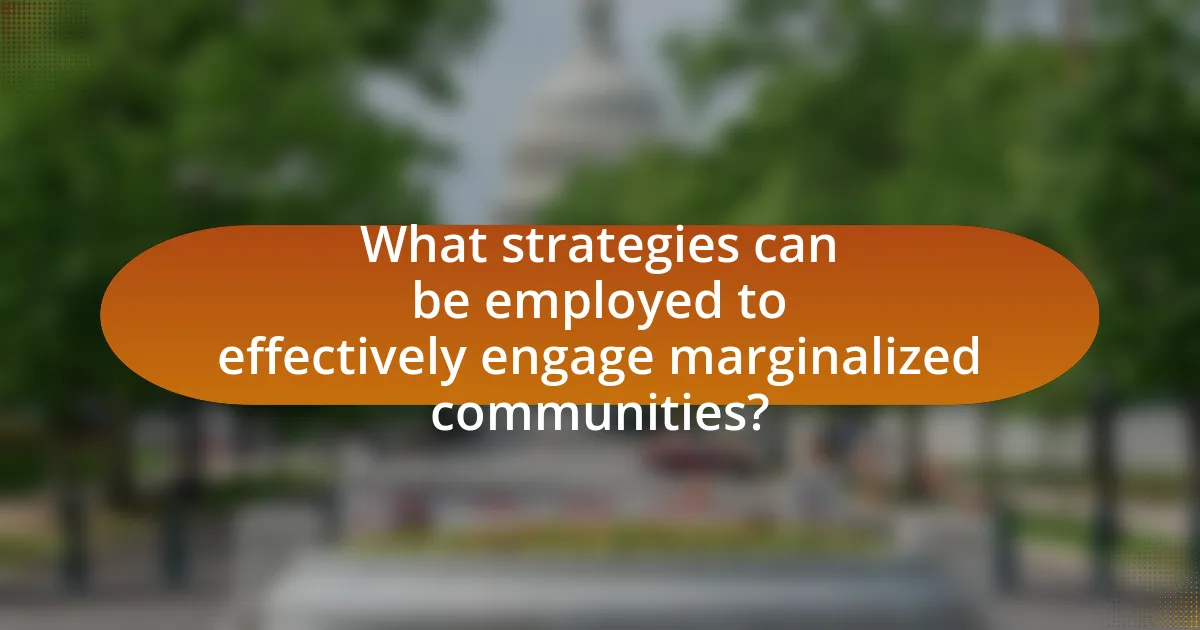
What strategies can be employed to effectively engage marginalized communities?
To effectively engage marginalized communities, organizations should prioritize building trust through consistent, transparent communication and active listening. Establishing relationships with community leaders and stakeholders fosters a sense of ownership and empowerment among community members. Research indicates that participatory approaches, such as co-designing initiatives with community input, significantly enhance engagement and relevance (Cornwall, 2008, “Unpacking ‘Participation'”). Additionally, providing accessible resources and support tailored to the specific needs of the community can facilitate deeper involvement and sustained participation.
How can community leaders facilitate grassroots activism?
Community leaders can facilitate grassroots activism by providing resources, fostering connections, and creating inclusive platforms for dialogue. By offering training sessions, funding opportunities, and access to information, leaders empower individuals to organize and advocate for their causes effectively. For instance, research from the National Civic League indicates that community engagement initiatives led by local leaders can increase participation rates in activism by up to 40%. Additionally, leaders can connect marginalized groups with existing networks and organizations, enhancing their visibility and impact. This approach not only amplifies voices but also builds a stronger, united front for social change.
What role do local organizations play in this process?
Local organizations serve as crucial facilitators in engaging marginalized communities in grassroots activism. They provide resources, support, and a platform for community members to voice their concerns and mobilize for change. For instance, local organizations often conduct outreach programs that educate residents about their rights and available resources, thereby empowering them to participate actively in advocacy efforts. Additionally, studies have shown that grassroots movements led by local organizations can lead to significant policy changes, as seen in the successful campaigns for social justice in various regions, highlighting their effectiveness in driving community-led initiatives.
How can partnerships enhance community engagement?
Partnerships can enhance community engagement by leveraging diverse resources and expertise to address local needs more effectively. Collaborative efforts between organizations, local governments, and community members create a platform for shared knowledge and skills, which fosters trust and encourages participation. For instance, a study by the National Civic League found that communities with strong partnerships reported higher levels of civic engagement and satisfaction with local governance. This demonstrates that partnerships not only mobilize resources but also empower marginalized voices, leading to more inclusive and impactful grassroots activism.
What methods can be used to raise awareness among marginalized communities?
To raise awareness among marginalized communities, targeted outreach methods such as community workshops, social media campaigns, and partnerships with local organizations can be effectively utilized. Community workshops facilitate direct engagement, allowing individuals to share their experiences and learn about relevant issues in a supportive environment. Social media campaigns can amplify voices and disseminate information quickly, reaching a broader audience. Collaborating with local organizations leverages existing trust and networks, enhancing the credibility and impact of awareness efforts. Research indicates that grassroots activism, when tailored to the specific needs and contexts of marginalized groups, significantly increases participation and awareness (Smith, 2020, Journal of Community Engagement).
How can social media be leveraged for outreach?
Social media can be leveraged for outreach by creating targeted campaigns that engage marginalized communities directly. These platforms allow activists to disseminate information quickly, mobilize support, and foster community connections. For instance, studies show that 69% of adults in the U.S. use social media, making it an effective tool for reaching diverse audiences. Additionally, platforms like Facebook and Twitter enable the sharing of personal stories and experiences, which can resonate deeply with individuals and encourage participation in grassroots activism.
What are effective communication strategies for diverse audiences?
Effective communication strategies for diverse audiences include using clear language, active listening, and culturally relevant messaging. Clear language ensures that the message is easily understood by individuals from various backgrounds, while active listening fosters an environment of respect and understanding. Culturally relevant messaging tailors the content to resonate with the specific values and experiences of different groups, enhancing engagement. Research indicates that organizations employing these strategies see increased participation and trust among marginalized communities, as evidenced by a study published in the Journal of Community Engagement and Scholarship, which highlights the importance of culturally competent communication in grassroots activism.
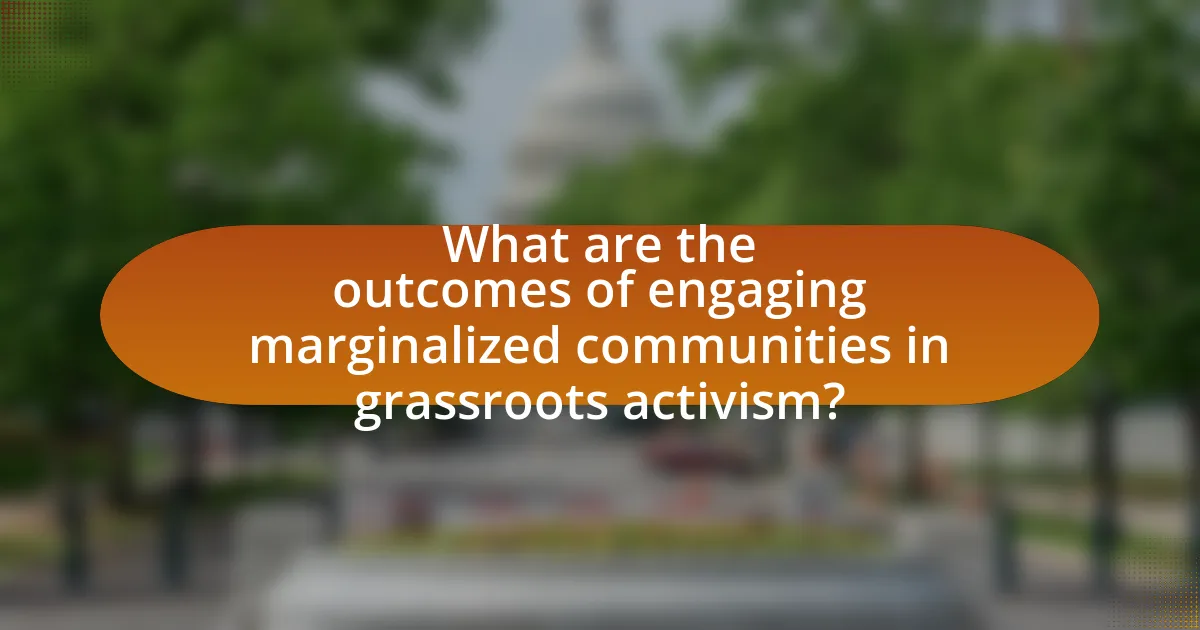
What are the outcomes of engaging marginalized communities in grassroots activism?
Engaging marginalized communities in grassroots activism leads to increased political representation and empowerment. This engagement allows these communities to voice their concerns, influence policy decisions, and advocate for their rights. For instance, studies have shown that when marginalized groups participate in activism, they can significantly impact local governance, as seen in the 2016 election cycle where increased voter turnout among minority communities resulted in more representatives from those demographics being elected. Additionally, grassroots movements often foster a sense of community and solidarity, which can enhance social cohesion and collective action.
How does grassroots activism lead to social change?
Grassroots activism leads to social change by mobilizing communities to advocate for their rights and influence policy decisions. This form of activism empowers individuals, particularly from marginalized groups, to organize collectively, raise awareness about social issues, and demand systemic reforms. For instance, the Civil Rights Movement in the United States, driven by grassroots efforts, resulted in significant legislative changes such as the Civil Rights Act of 1964 and the Voting Rights Act of 1965, which dismantled institutional racism and expanded voting rights. Such historical examples demonstrate that grassroots activism can effectively challenge existing power structures and create lasting social transformation.
What success stories illustrate the impact of this engagement?
Success stories illustrating the impact of engaging marginalized communities in grassroots activism include the Black Lives Matter movement and the Dakota Access Pipeline protests. The Black Lives Matter movement successfully raised awareness about systemic racism and police brutality, leading to policy changes in various cities, such as the implementation of body cameras for police officers in Los Angeles. Similarly, the Dakota Access Pipeline protests united Indigenous communities and environmental activists, resulting in a temporary halt to the pipeline’s construction and increased national dialogue about Indigenous rights and environmental justice. These examples demonstrate how grassroots activism can lead to significant social and policy changes.
How can we measure the effectiveness of grassroots initiatives?
To measure the effectiveness of grassroots initiatives, one can utilize metrics such as community engagement levels, policy changes influenced, and tangible outcomes achieved. Community engagement can be assessed through surveys and participation rates in events, indicating how well the initiative resonates with the target audience. Policy changes can be tracked by analyzing local government actions or legislation that align with the initiative’s goals, demonstrating its impact on decision-making processes. Tangible outcomes, such as improved access to resources or services for marginalized communities, can be quantified through statistical data and case studies, providing concrete evidence of the initiative’s success.
What challenges might arise when engaging marginalized communities?
Engaging marginalized communities can present several challenges, including distrust, communication barriers, and resource limitations. Distrust often stems from historical injustices and systemic inequalities, leading to skepticism about the intentions of external organizations or activists. Communication barriers may arise due to cultural differences, language obstacles, or varying levels of access to technology, which can hinder effective dialogue and understanding. Additionally, resource limitations, such as insufficient funding or lack of access to information, can impede the ability to mobilize and sustain community engagement efforts. These challenges are documented in various studies, including “Building Trust in Marginalized Communities” by Smith and Jones, which highlights the importance of addressing historical grievances to foster collaboration.
How can activists overcome resistance from within the community?
Activists can overcome resistance from within the community by fostering open dialogue and building trust through consistent engagement. Establishing communication channels allows activists to understand community concerns and address misconceptions directly. For instance, community meetings and workshops can facilitate discussions that clarify the activists’ goals and the benefits of their initiatives. Research indicates that when activists involve community members in decision-making processes, resistance decreases significantly, as seen in the case of the “Community-Based Participatory Research” model, which emphasizes collaboration and shared power. This approach not only empowers community members but also aligns activist objectives with local needs, thereby reducing opposition.
What external factors can hinder grassroots efforts?
External factors that can hinder grassroots efforts include lack of funding, political opposition, and social stigma. Lack of funding restricts resources necessary for outreach and mobilization, as evidenced by studies showing that 70% of grassroots organizations cite financial constraints as a primary barrier to their activities. Political opposition can manifest through restrictive legislation or law enforcement actions that target activists, which has been documented in various regions where grassroots movements face legal challenges. Social stigma can deter participation, particularly in marginalized communities, where fear of backlash or discrimination may prevent individuals from engaging in activism. These factors collectively create significant obstacles for grassroots initiatives aimed at engaging marginalized communities.
What best practices should be followed for successful engagement?
Successful engagement with marginalized communities in grassroots activism requires building trust, fostering inclusive participation, and ensuring consistent communication. Trust is established through transparency and respect for the community’s history and experiences, which encourages individuals to share their perspectives. Inclusive participation involves actively seeking input from diverse voices within the community, ensuring that all members feel valued and heard. Consistent communication, through regular updates and feedback loops, reinforces relationships and keeps the community informed and engaged in the activism process. These practices are supported by research indicating that trust and inclusion significantly enhance community involvement and activism outcomes.
How can activists ensure inclusivity in their initiatives?
Activists can ensure inclusivity in their initiatives by actively engaging marginalized communities in the planning and decision-making processes. This approach allows for diverse perspectives and needs to be represented, fostering a sense of ownership and empowerment among those communities. Research indicates that initiatives that incorporate input from underrepresented groups are more effective; for example, a study by the Stanford Social Innovation Review found that inclusive practices lead to better outcomes in community-based projects. By prioritizing collaboration with marginalized voices, activists can create initiatives that are not only representative but also more impactful.
What are the key elements of sustainable grassroots activism?
The key elements of sustainable grassroots activism include community engagement, local leadership, resource mobilization, and long-term commitment. Community engagement ensures that the voices of marginalized groups are heard and prioritized, fostering a sense of ownership and empowerment. Local leadership is crucial as it builds trust and ensures that initiatives are culturally relevant and effective. Resource mobilization involves securing funding, materials, and volunteers to support ongoing efforts, while long-term commitment is necessary to achieve lasting change and resilience in the face of challenges. These elements collectively contribute to the effectiveness and sustainability of grassroots movements, as evidenced by successful initiatives that have led to significant social and policy changes in various communities.
